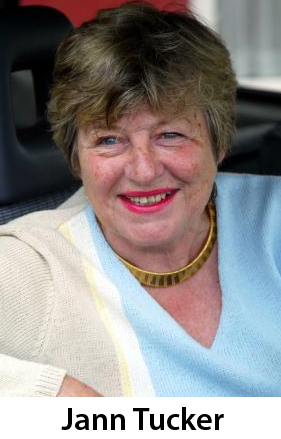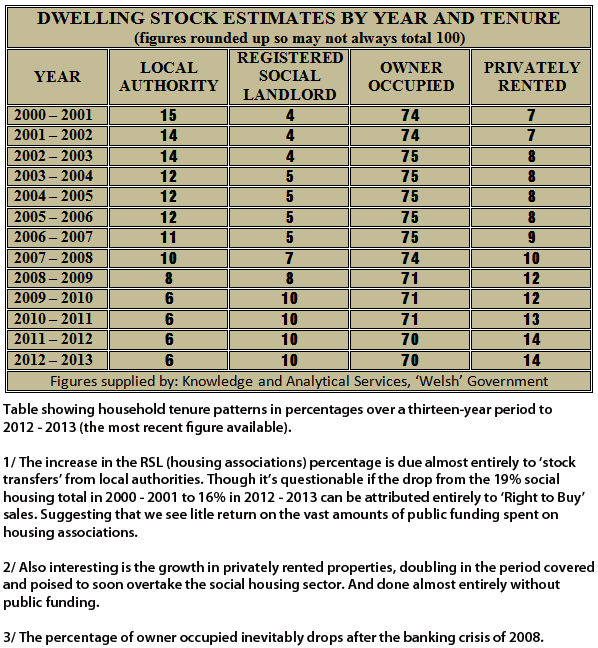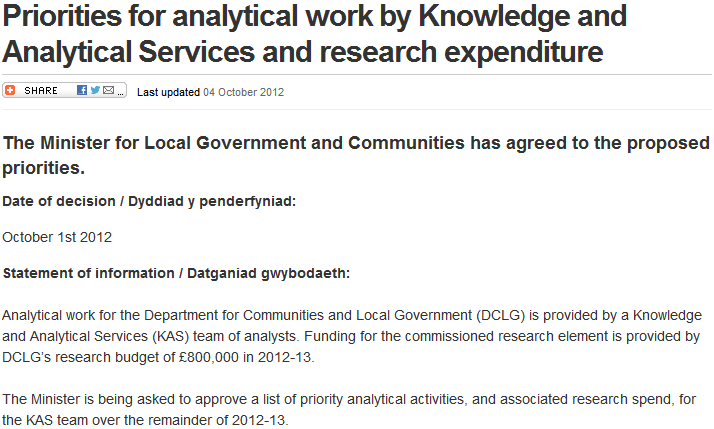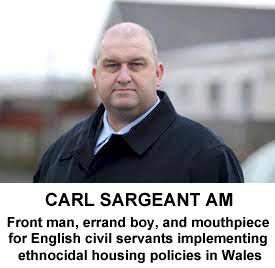CARDIGAN CASTLE
I don’t want anyone to think I’m picking on the women running and wrecking the Cardigan Castle project (nor would I want anyone to think I plan on ignoring them!) but I couldn’t write this post without a mention of developments since my previous post. Here’s a selection.
Someone informed me that at one meeting Jonathan ‘Joff’ Timms opined that Rhys ap Gruffydd and his sons were “nothing but savages”. Which again raises the question: Who the hell is Jonathan Timms and who invited a man living in Kent, England, to get involved?
Another informant sent me a copy of a letter sent to the Carmarthen Journal about three or four years ago, which served to revive an earlier suspicion that the Castle project may be disguising an even more self-serving undertaking involving property grabbing, and that this explains the two trusts. (I would appreciate a good photograph of the Green Street properties.) Elin Jones’ remarks are worth noting.
I am indebted to a third informant for this link which suggests that the Facilities Officer vacancy – the post now filled by Sue “ENGLISH” Lewis – was advertised from December 23rd 2014 to midday on January 2nd 2015. In other words, from Christmas Eve to New Year’s Day. How the hell were they allowed to get away with this?
Rumours persist that non-Gang of Four trustees are ready to jump ship, leaving mesdames Tucker, Lewis, Davies and Jones even more exposed. Moves are also afoot to call an Emergency General Meeting.
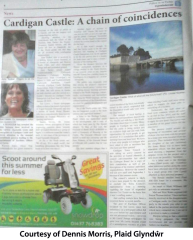
Equinox, the Cardiff PR firm working for the Gang of Four, has requested an urgent meeting with local critics. This panic move may have been instigated by the project’s funders becoming worried by the amount of shit now hitting the fan.
Gareth Gregory, the Heritage Lottery Fund’s man on the case, is known to be in the pockets of the Gang of Four. Or should that be ‘handbags’? Or would that be sexist? Who cares?
Here’s the ‘Rhys ap Gruffydd’ Proclamation read out at 7pm on Saturday outside the Castle main entrance, which I understand will also be read out at the Meifod Eisteddfod.
Elsewhere, the Pembrokeshire Herald and its Carmarthenshire sister-paper ran full-page pieces using much of the information I’d supplied on my blog. I only have a photo of the article as I couldn’t get a copy of the newspaper to scan for you, but I was sent a transcript, which you can read here.
Saturday night saw the Bellowhead concert at the Castle. To judge by the photograph I was sent the audience was in the age group 55 – telegram from Beti.
However successful the Gang of Four may want us to believe the Bellowhead concert was I can’t help thinking that a performance of Wagner would have been more appropriate given the situation they’re in, for Götterdämmerung is surely approaching. I’d just love to see the lot of them in horned helmets, wielding spears and shrieking, as a local mob storms the castle. Well, laff!
STOP PRESS: I am now told that during the interval, and at her insistence, Vicky Moller, Plaid Cymru list candidate in Mid and West Wales, was led to the mic by compère, Brychan Llyr (Dic Jones’ son, of Jess fame). She gave a rousing speech, saying that without the diligence and hard work of Cris Tomos (now given the elbow) the renovation would not have been possible. Brychan expressed similar sentiments. Then the control freak Gang of Four tried to prevent Brychan from introducing Bellowhead, but after much heated discussion he did, before leaving the castle grounds.
Finally, the Aberporth connection has been strengthened with information about the bizarre, oversized ‘bardic’ chair to be found at the Castle. Here’s a photo I took on my visit a couple of weeks ago of my wife sitting in it. (No, she hasn’t got a round, flat, black head,) This chair is said to have cost £12,000 but no one seems to recall any tendering process. The artist responsible is a Paul Clarke of . . . Aberporth! He has done work in Aberporth, paid for by the community council, on which body we of course find Jann Tucker. I suggest you read the comments by ‘Rhodri’ to my previous post. He also suggests that the escutcheons and armorials employed are not authentic, having little or nothing to do with Rhys ap Gruffydd, The Lord Rhys.
THIS WEEK’S COMPETITION: Find someone living in Aberporth – or just having a holiday home there – who has not gained financially from the largesse of Lady Tucker of Cardigan Castle.
*
ORGAN ‘HARVESTING’
Not a subject I’d normally write about but friends of mine in Llanelli got to thinking about the ‘Welsh’ Government’s proposal to assume that if you don’t expressly say No then you agree to have your organs whipped out and re-used ASAP after your encounter with the Grim Reaper. The leaflet they were reading gave a phone number, and this took them to a call centre in Bristol, and a helpful young Bristolian. This, remember, was for enquiries into a ‘Welsh’ Government initiative.
The big question they asked was, ‘If I agree to donate my organs, or don’t opt out of any new scheme of assumed donation, will my organs stay in Wales (cos they’ll only get homesick otherwise)?’ ‘Er, no, they can end up anywhere in Englandandwales’. ‘Hang on, you’re saying there’ll be an opt-out system in Wales running parallel with an opt-in system in England?’ ‘Um, yes’. ‘Which will mean that the vast majority of the organs taken from Welsh stiffs will end up giving new life to our English neighbours?’ ‘Yup, that’s about the size of it’.
At this point my friends thought they’d be clever and demand the Welsh language service, as the leaflet said they could. ‘I’ll get someone to ring you back’, said the HYB. After half an hour or so the call came, again from Bristol. The Welshman they spoke with said he enjoyed working in Bristol because he and the other Welsh speakers get paid more than their English colleagues because they also answer calls in English. (Which must do wonders for workplace harmony and Welsh-English relationships!)

So there you are, if you agree to donate your organs, or don’t opt out of presumed consent, your kidneys could end up keeping alive a frothing-at-the-mouth Kipper, your liver in some Daily Mail journo. This is the kind of insane situation that can only arise when certain powers are devolved within an overarching Englandandwales framework. This is the sham devolution we have in Wales, and in this instance it appears that Wales is being used by England for organ harvesting – with the co-operation of the ‘Welsh’ Government!
*
OVERSEAS AID PROGRAMME
I bet that heading surprised you! It certainly surprised me when I discovered that the poorest part of Europe, a country that has received billions in EU aid, is sending money to Africa. Let me explain.
On June 18th I posted ‘Welsh Poverty and “Welsh” Labour’s Third Sector Money Pit‘ and in that post I looked at the careers of husband and wife team Travers Merrill and Rose Mutale Nyoni Merrill. Travers was at the helm when the good ship Rhondda Life hit the rocks, while Rose’s Third Sector racket is BAWSO. Together they also run a private endeavour called ABESU, which, to quote the company’s website, is “a UK charity working in partnership with the ABESU Women’s Housing Co-operative in Zambia to self-build houses and establish sustainable livelihoods”. Nothing surprising there, seeing as Mrs Merrill is from Zambia.
Curiosity drove me to flick through the ABESU accounts, where I found that in the year ended March 31st 2014 ABESU had received £2,000 from the ‘Welsh’ Government. Not a great amount, but why is our puppet regime down Cardiff docks giving anything to an organisation that doesn’t even operate in Wales? As is my wont, I submitted an FoI on June 22nd. On July 1st I received an acknowledgement that promised an answer by July 16th. When that hadn’t arrived by July 23rd I wrote again, and my answer came the following day. You can read that letter by clicking here.
I asked the ‘Welsh’ Government to:
1. Confirm or deny that the Welsh Government gave Abesu £2,000.
2. If confirmed, please explain the reason for the Welsh Government giving £2,000 to Abesu, and from which funding ‘pot’ the money came.
3. Confirm or deny that the Welsh Government gives funding to other organisations that do not operate in Wales.
4. If confirmed, please supply a list of such organisations together with the amounts given, and from which ‘pots’ the funding is secured.
The response I got, from ‘the Office of the First Minister and Cabinet Office’ (‘Cabinet Office’ FFS!) said:
“I can confirm that a grant of £2000 was given to Abesu. This was by way of a grant from the Wales Africa Community Links project which was run by Wales Council for Voluntary Action (WCVA) and funded by the Welsh Government’s Wales for Africa programme.
I can confirm the Welsh Government does provide funding to other organisations that do not operate in Wales. However, with regard to the list of organisations and the amounts given, I have estimated that it will cost more than the appropriate limit established in the Freedom of Information and Data Protection (Appropriate Limit and Fees) Regulations 2004 to consider your request and because of this the regulations allow me to refuse to deal with it.”
The letter went on to explain why I would not have a full response, ‘over the £600 limit’, etc. A couple of sentences in this explanation caught my eye, and you may also find them interesting. They said: “The Welsh Government’s finance system contains over 14,500 companies and organisations whose address is outside of Wales. During financial year 2014/15 there was (sic) 2,331 transactions made against these companies”. Suggesting that far too much of the money spent by the ‘Welsh’ Government is leaving Wales.

Anyway, returning to the ‘Welsh’ Government’s Wales for Africa programme. With the best will in the world, it’s difficult not to see this as yet another excuse to give money to Labour’s cronies in the Third Sector. This time by sending them on African jollies to “enhance their leadership skills” and have their photographs taken with ever-so-grateful Africans. For more information just follow the link I’ve supplied, and use the drop-down menu on the right-hand side of the page.
This kind of lunacy is almost bound to happen in the system of sham devolution we know in Wales. We have a bunch of pseudo socialists (many just pseuds) behaving as if they’re running a real government. And of course, the civil servants who really run Wales, and their masters in London, are more than happy to let these self-deluding buffoons waste our money.
Message to Carwyn and the gang: Stop playing stupid games; you are not a real government, Wales is poor, so we do not have money to spare for Polly and Dominic to go showboating in Africa.
*
HOUSING ASSOCIATIONS
When it comes to events and functions, weddings and conferences Cardigan Castle may not be seeing many paying customers, but one organisation that has been there a couple of times is Cantref, the housing association and white trash importer. A comment to my post The Colonisation of Wales: Help Needed tells us that things got a bit out of hand at Cantref’s AGM when, for some reason, the tenants were bused in for a hog roast and all the booze they could drink! Read the comment for yourself.
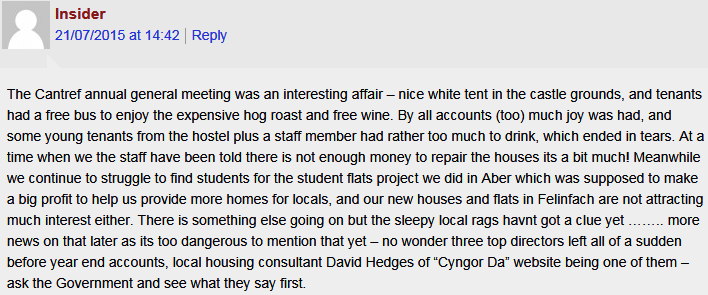
This munificence is surprising given that Cantref may be entering Shit Creek. (Regularly laying out a few grand on hog roasts and piss-ups don’t help!) For the comment tells us that some of the commitments Cantref has taken on, such as the student accommodation in Aberystwyth, may not be turning out as planned. Hardly surprising when we see Aberystwyth Uni slipping down the league table faster than Cardiff City. Boom! boom! (Couldn’t resist it!)
‘Insider’ also tells us that, “There is something else going on but the sleepy local rags haven’t got a clue yet . . . more news on that later as it’s too dangerous to mention that yet – no wonder three top directors left all of a sudden before year end accounts, local housing consultant David Hedges of Cyngor Da being one of them”. David Hedges is the son of the former Glamorgan cricketer Bernard Hedges, who died in February 2014. (Many is the time I saw Bernard Hedges play at St. Helen’s.) His website, particularly the bullet point ”Cyngor Da’s approach’ is unmitigated Third Sector bollocks-speak. And although the stars favoured him with a Swansea birth Dai seems to have headed into the sunset and relocated to Cardigan.

Naturally I tried to make enquiries into Cantref’s financial health, but unless you’re prepared to pay through the nose for them there’s no way of getting the figures. The problem is the status of housing associations. If they were charities then it would be a simple matter to visit the Charity Commission website and get the latest accounts gratis. If they were companies then it would be easy to get a financial picture from any number of sites, and pay for specific documents. These would also be available – and usually cheaper – on the Companies House website.
But because housing associations are Industrial and Provident Societies, registered under the Co-operative and Community Benefit Societies and Credit Unions Act 1965 it means they are registered with, but not regulated by, the Financial Services Authority, which then means you have to apply for any document you want and the cost becomes prohibitive.
No doubt defenders of housing associations will tell us that there is usually an annual report available on their websites. Rubbish, just look at the Cantref Annual Report, it’s just flim-flam and photographs, no better than propaganda, and nothing like the audited accounts available for charities and private companies. And if that wasn’t bad enough, housing associations are not covered by the Freedom of Information Act, unlike your local council’s housing department . . . assuming your local council’s housing stock hasn’t been taken over by a secretive and acquisitive housing association.
I don’t believe that housing associations should be regarded as anything other than the private companies they are. Put quite simply, housing associations do not meet the criterion used by the FSA for Industrial & Provident Societies: “An industrial and provident society is an organisation conducting an industry, business or trade, either as a co-operative or for the benefit of the community“.
It is now anomalous that they are treated the same as community organisations and private members clubs. They are – in all but name – private companies, consequently there should be no more funding from the public purse.
*
LABOUR LEADERSHIP CONTEST
Another subject you may be surprised to find me writing about. And while I can’t deny deriving a great deal of pleasure from seeing the bruvvers and sissters poking each other in the eyes this is, I assure you, an attempt to make a more profound observation.
Last Wednesday I watched a debate on Newsnight between three Labour MPs, Mary Creagh, Emily Thornberry and Diane Abbott. It seems that Creagh and Thornberry nominated Jeremy Corbyn for the leadership, but had no intention of voting for him, and were now worried that this ‘oppositional’ candidate might win! Abbott was there, presumably, to speak up for Corbyn.
We were also treated to a film of an increasingly wild-eyed and delusional Tony Blair telling his party’s members that if their heart said Corbyn then they should get a transplant! His former ‘advisor’, John McTernan, called those MPs who nominated Corbyn “morons”. It’s worth reminding ourselves that the most recent entry on McTernan’s CV is Chief of Staff to Jim Murphy, leader of ‘Scottish’ Labour in May. The political equivalent of being Custer’s chief scout at the Little Big Horn.
Anyway, the issue seems to be that the great majority of Labour MPs think Corbyn is too Left wing, but at the time of the Newsnight broadcast polls had him as the most popular choice, certainly with trade unionists and ordinary branch members. Which has left Creagh, Thornberry, Margaret Beckett (who’s admitted to being a ‘moron’!) and others suffering from Dr Frankenstein syndrome. It was one of the most enjoyable Newsnights I’ve seen for some time.
To justify rejecting Corbyn Creagh and Thornberry used the argument that Labour would be unelectable with Corbyn in charge, and unless the party wins the next election then Labour will be unable to help the people. Persuasive . . . until they expanded on that and you realised that for them winning elections is an end in itself, and this, they believe, can only be achieved through Labour being indistinguishable from the Conservatives.
The name Emily Thornberry rang a bell with me, but I had to check before I realised that she it was who had insulted the flag of England and those who proudly wave it. She was condemned as a snob for that episode, and watching her on Newsnight I could see why. It was an almost unique experience: she spoke well, her arguments were well marshalled, and yet . . . rarely have I heard anyone be simultaneously eloquent and repulsive.
She is clearly arrogant, to the extent that she kept cutting across Kirsty Wark! (Isn’t that a hanging offence?) But it was her patronising and condescending attitude towards Diane Abbott that really clinched it. She was, and in a way one rarely sees outside of the theatre or television, looking down her nose at the MP for Hackney North and Stoke Newington.
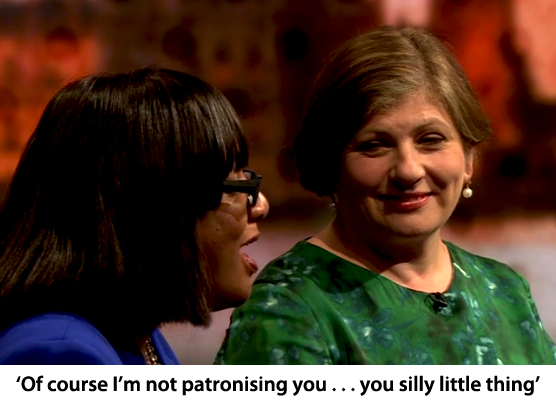
The Labour Party has a massive problem on its hands with this election, for it has exposed the chasm between the unworldly professional politicians in the Westminster bubble and those ordinary party members who oppose starving the poor, who believe in pursuing tax dodgers, and who are clearly unhappy with a Labour Party that is little more than the Conservative Party by another name.
Lubbly jubbly! Vote Corbyn! A las barricadas!

